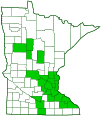dimorphic jumper
(Maevia inclemens)
Conservation • Description • Habitat • Biology • Distribution • Taxonomy
Conservation Status |
|
|||||||
| IUCN Red List | not listed |
|||||||
| NatureServe | NNR - Unranked SNR - Unranked |
|||||||
| Minnesota | not listed |
|||||||
Description |
||
Dimorphic jumper is a medium-sized jumping spider. It occurs throughout eastern United States east of the Great Plains and in adjacent Canadian provinces. In Minnesota, it is most common in the southeast and metro regions, where it is at the westernmost extent of its range. It is found on trees, shrubs, and grasses. It has adapted well to man-made structures, and is found in outbuildings, on fences, and under boards. The female is ¼″ to ⅜″ (7 to 10 mm) long. The plate covering front part of the body (carapace) is longer than wide, widest behind the eyes, evenly rounded on the lateral margins, and high, between 60% to 70% as high as wide. It is mottled light brown and dull dark brown or black. There is a thin, dark brown or black, longitudinal line in the middle beginning behind the last row of eyes and extending to the rear. There are four pairs of eyes arranged in what appears to be three rows. The first row of four eyes is recurved. The middle and forward-most pair of these is by far the largest of all of the eyes and can be moved. The second row of two eyes is closer to the first row than it is to the third row. The eyes in the second row are the smallest, and are barely or not at all noticeable on most photos. The third row is set far back on the head. The second and third rows form a wide rectangle. There is usually a orangish eyeline on each side beginning at the lateral eye in the first row and passing through the eye in the third row. The jaws (chelicerae) are small and may be dark or light. There are two sensory appendages (palps) associated with the mouthparts, and they may be dark, light, or spotted. The abdomen is gray with an iridescent dark reddish band on each side separated by a row of reddish chevrons, at least toward the rear. The front and sides of the abdomen are marked with many short dark bars. The legs are short, pale, yellowish, and unmarked. Males have two color forms. The light form is similar to the female in appearance. The legs are pale and are usually spotted and lined. Dark form males are very dark brown to almost completely black. Markings on the abdomen may be completely obscured. The legs are usually pale and completely unmarked. |
||
Size |
||
Female Body Length: ¼″ to ⅜″ (7 to 10 mm) Male Body Length: 3 ⁄16″ to ¼″ (5 to 7 mm) Legspan: ⅜″ to ½″ (9 to 12 mm) |
||
Web |
||
Jumping spiders do not hunt from webs. |
||
Similar Species |
||
Habitat |
||
Trees; shrubs; grasses; man-made structures, including fences and outbuildings; and under board on the ground |
||
Biology |
||
Season |
||
|
||
Behavior |
||
|
||
Life Cycle |
||
|
||
Food |
||
Insects and other spiders |
||
Distribution |
||||
|
Sources 24, 29, 30, 82. |
|||
| 5/25/2022 | ||||
Occurrence |
||||
|
||||
Taxonomy |
|||
| Class | Arachnida (arachnids) | ||
Order |
Araneae (spiders) | ||
Suborder |
Araneomorphae (typical spiders) | ||
| Infraorder | Entelegynae | ||
Superfamily |
Salticoidea | ||
Family |
Salticidae (jumping spiders) | ||
Subfamily |
Salticinae (typical jumping spiders) | ||
Tribe |
Dendryphantini | ||
| Subtribe | Marpissina | ||
Genus |
Maevia | ||
In a revision of the genus Maevia published in 1955, the author proposed separating the species into two subgenera, Maevia and Paramaevia. Under this classification, Maevia inclemens is in the subgenus Maevia. The proposal has not been widely accepted. |
|||
Synonyms |
|||
|
|||
Common Names |
|||
dimorphic jumper dimorphic jumping spider |
|||
Glossary
Carapace
The hard, upper (dorsal), shell-like covering (exoskeleton) of the body or at least the thorax of many arthropods and of turtles and tortoises. On crustaceans, it covers the cephalothorax. On spiders, the top of the cephalothorax made from a series of fused sclerites.
Cephalothorax
The front part of a spider’s body, composed of the head region and the thoracic area fused together. Eyes, legs, and antennae are attached to this part.
Chelicerae
The pair of stout mouthparts, corresponding to jaws, in arachnids and other arthropods in the subphylum Chelicerata.
Palp
Short for pedipalp. A segmented, finger-like process of an arthropod; one is attached to each maxilla and two are attached to the labium. They function as sense organs in spiders and weapons in scorpions.
Visitor Photos |
|||||
Share your photo of this arachnid. |
|||||
| This button not working for you? Simply email us at info@MinnesotaSeasons.com. Attach one or more photos and, if you like, a caption. |
|||||
Alfredo Colon |
|||||
 |
|||||
MinnesotaSeasons.com Photos |
|||||
|
|||||

Slideshows |
||

Visitor Videos |
|||
Share your video of this insect. |
|||
| This button not working for you? Simply email us at info@MinnesotaSeasons.com. Attach a video, a YouTube link, or a cloud storage link. |
|||
Other Videos |
|||
| Maevia inclemens (Walckenaer, 1837) Middlesex Co., MA ♂ (2 forms)♀ Dick Walton |
|||
About
Published on Nov 25, 2010 For narrative account, additional data, and usage see: http://www.rkwalton.com/salticids/Maevia_inclemens.php |
|||

Created: 4/17/2019
Last Updated:


